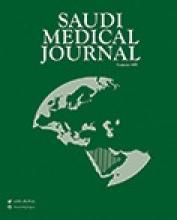Abstract
OBJECTIVE: Knowledge of the pattern of gastrointestinal tract (GIT) disorders detected by endoscopy is important for clinicians. The objective of this paper is to report on the indications and yield of endoscopy.
METHODS: Retrospective analysis of data of all patients below 18 years of age who underwent upper GIT endoscopy from 1414 H (1993 G) through to 1424 H (2002 G) over a 10-year period at King Khaled University Hospital, Riyadh, Kingdom of Saudi Arabia.
RESULTS: One thousand and fifteen upper GIT endoscopies were performed, of which 851 diagnostic procedures were performed on 851 children. The majority (96%) were Saudi nationals, the age range was between 4 days and 18-years, and the male to female ratio was 0.7: 1. The 2 most common indications were duodenal biopsy (29%) and abdominal pain (24%). The best diagnostic yield was in children presenting with ingestion of caustic substances, followed by hematemesis, and vomiting in 86%, 75% and 67%. The overall yield, however, was 43%. Finally, the most common diagnoses were gastritis and esophagitis occurring in 32% and 30% of the children. Age related variations are reported.
CONCLUSION: The increasing practice of endoscopy in children resulted in the development of new indications such as endoscopic small bowel biopsy. The differences in indications and yield of endoscopy with age reflecting the varying pattern of diseases.
- Copyright: © Saudi Medical Journal
This is an open-access article distributed under the terms of the Creative Commons Attribution-Noncommercial License (CC BY-NC), which permits unrestricted use, distribution, and reproduction in any medium, provided the original work is properly cited.






